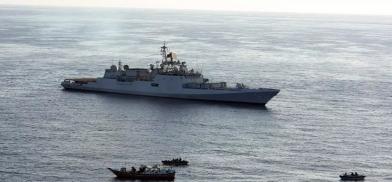India braces for China's growing muscle-flexing in the Indian Ocean
The establishment of a second naval base in Lakshadweep, INS Jatayu is a key part of this strategy. It's a calculated move to counter China's influence in the Indian Ocean Region.

With India planning to test at least one more nuclear ballistic missile soon, tensions are simmering in the Indian Ocean. This development coincides with the arrival of a new Chinese "spy ship" in the region, further fueling anxieties. The Indian Ocean, a vast maritime highway crucial for global trade, has long been a strategic arena for regional powers. It has long been a significant conduit for international trade and a vital geopolitical location for regional nations. But a new player has entered the picture in recent decades, raising concerns and changing the global landscape. China now has a significant military presence in the Indian Ocean, a growing economy, and strategic investments in important infrastructure projects. Concerns have been raised throughout the area by this increase in activity, especially for India, the long-standing dominant force.
China's growing footprint in the Indian Ocean marks a significant shift in its strategic focus. Historically, China's attention was primarily on the East China Sea. This recent development can be understood through a combination of economic and strategic motivations.
Economically, the Indian Ocean is a vital artery for China's trade. In 2022 alone, trade with Africa soared to $243 billion, highlighting the importance of securing these sea routes. Additionally, the Indian Ocean holds vast reserves of oil and natural gas, resources China heavily relies on. Strategically, China's growing naval presence showcases its ambition as a global power. Participation in anti-piracy operations and the development of its first overseas military base in Djibouti are testaments to this. This expansion can also be seen as a way to counterbalance American influence, which has long been strong in the Indian Ocean. China aspires to establish itself as a major security player in the region. Additionally, a strong military presence deters potential challenges from India and other regional rivals, protecting Chinese interests.
India, with its vast coastline and historical dominance in the Indian Ocean trade, views China's expanding presence with deep concern. India has long been the primary security provider in the region, with annual military spending exceeding $80 billion in 2022. However, India's once-dominant Indian Ocean navy faces a rising China. China's rapid naval expansion threatens the established order, raising concerns for India's ability to secure vital sea lanes and deter potential threats.
China's growing military presence
China's close partnership with Pakistan adds another layer of complexity. Gwadar Port in Pakistan, developed with substantial Chinese support, provides China with a strategic foothold in the Arabian Sea. This strategically located port allows China to potentially monitor Indian naval movements and project its own power further into the Indian Ocean.
China's growing economic clout also presents a significant challenge to India's established partnerships with regional countries. China's ambitious Belt and Road Initiative (BRI) offers infrastructure loans to developing nations across the Indian Ocean. While these loans can be beneficial for initial development, they can also act as a form of debt-trap diplomacy. The sheer scale of China's economic influence is daunting. Smaller nations in the region often lack the robust economies to manage such large debts. This vulnerability creates a scenario where struggling countries become overly reliant on China for future infrastructure projects, potentially swaying their political and economic allegiances away from India. The case of Sri Lanka serves as a stark example. The country, burdened by Chinese debt, was ultimately forced to lease Hambantota Port to China on a 99-year lease. This raises serious concerns about potential Chinese control over other strategically important ports in the Indian Ocean, potentially disrupting vital trade routes and hindering India's regional influence.
The Indian Ocean is an economic and security lifeline for India. The vast ocean also serves as a strategic buffer, but potential threats can arise from both land and sea. One concern for India is China's growing military presence in the region, including expanding military capabilities and strategic investments. This has prompted India to develop a multi-pronged approach to address this growing influence.
Transformation in Indian thinking
Prime Minister Narendra Modi's speech in Seychelles and Mauritius in 2015 signaled a dramatic transformation in India's perception of the Indian Ocean. Previously, India advocated for a neutral Indian Ocean free from external powers. Modi, however, outlined a five-point plan that charted a new course. This plan emphasized regional security cooperation with countries bordering the Indian Ocean. In a significant departure from past policies, Modi acknowledged the role external powers could play in securing the Indian Ocean.
To further bolster its position, India is actively modernizing its military, particularly the navy. This includes building new submarines, aircraft carriers, and other warships. The naval defense budget continues to increase each year—the proportion of the navy's budget for buying new platforms and equipment went up by 45 percent in 2022 alone, and the largest proportion of the increase in the defense budget went to the navy. Additionally, India is strengthening its strategic partnerships with other regional and global powers like the United States, Japan, and Australia. Joint military exercises like Malabar showcase a united front against Chinese expansionism and serve as a deterrent to aggressive actions.
The establishment of a second naval base in Lakshadweep, INS Jatayu is a key part of this strategy. It's a calculated move to counter China's influence in the Indian Ocean Region. China has been actively pursuing its "String of Pearls" strategy, establishing port facilities and military outposts throughout the region. This strategy is seen by India as a threat to its security and dominance in the Indian Ocean. The Lakshadweep base, strategically located closer to key shipping lanes and potential flashpoints, will allow India to project its naval power more effectively. It will improve India's ability to monitor and respond to Chinese activities in the region, deterring any aggressive actions. Additionally, the base can serve as a logistical hub for supporting patrols, search and rescue operations, and humanitarian missions in the Indian Ocean.
The future of the Indian Ocean hinges on a delicate balancing act. Both China and India are formidable forces, vying for influence. Whether the region fosters peaceful co-existence or descends into escalating tensions will depend on their ability to navigate their strategic ambitions and find common ground on maritime security. Collaborative efforts to ensure freedom of navigation and address shared threats like piracy will be paramount. Finding a path towards regional stability will require open communication, mutual respect for core interests, and a commitment to peaceful resolution of disputes. Only through such cooperation can the Indian Ocean continue to serve as a vital economic artery and a zone of peace for all nations.
(The writer is pursuing a Masters in Political Science from Hindu College, University of Delhi. Views are personal. He can be contacted at rakshit2k2@gmail.com)














Post a Comment